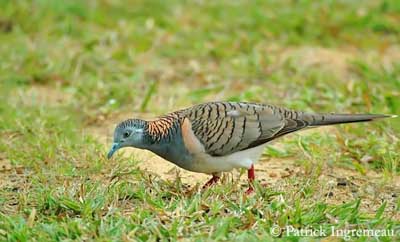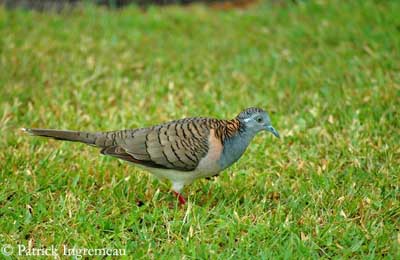
Bar-shouldered Dove
Geopelia humeralis
Columbiforme Order – Columbidae Family
BIOMETRICS:
Length: 26-29 cm
Weight: 130gr
DESCRIPTION:
Bar-shouldered Dove is native to Australia.
Adult has grey-brown upperparts. Hind neck shows a bright coppery patch, barred with black. Long tail is graduated. Outer feathers are tipped white.
Underparts are whitish, washed pink on lower breast.
Head and breast are grey. Bill is pale grey. Eyes are pale brown to pale yellow, with blue-grey or pinkish eye-ring. Legs and feet are pinkish-red.
Both sexes are similar.
PROTECTION / THREATS / STATUS:
Bar-shouldered Dove is common around human areas, even in streets in some cities. Clearing for agriculture is beneficial for this species.
Introduced species such as Spotted Turtle-dove, involved the displacement of Bar-shouldered Doves in other natural areas, however, numbers are increasing in southern Australia, particularly in north-western Victoria.
Fr: Géopélie à nuque rousse
All : Kupfernackentäubchen
Esp : Tortolita Humeral
Ital : Tortora spalle barrate
Nd : Roodnek-zebraduif
Russe : Медношейная полосатая горлица
Photographs by Patrick Ingremeau
His website: TAMANDUA
Text by Nicole Bouglouan
Sources:
PIGEONS AND DOVES by David Gibbs, Eustace Barnes and John Cox - Pica Press Sussex - ISBN: 1873403607
HANDBOOK OF THE BIRDS OF THE WORLD vol 4 by Josep del Hoyo-Andrew Elliott-Jordi Sargatal - Lynx Edicions - ISBN: 8487334229
Birds in backyards (Birds Australia and Australian Museum)
Wikipedia (Wikipedia, The Free Encyclopedia)

Juvenile resembles adults, but it is browner. Barring is less distinct. We can see buff fringes to most of feathers. Head is browner and hind neck is dull rufous.
One subspecies, Geopelia humeralis hedlandi, which lives in northern parts of the range in the Pilbara region, is paler in colour.
VOICE: SOUNDS BY XENO-CANTO
Bar-shouldered Dove can utter several kinds of calls. The most common is a loud “cook coo cook coo” usually repeated 2 or 3 times as advertising call. It also utters disyllabic “coo-hoo” repeated, ending in single “coo”.
It also gives another call, similar to advertising call, but ending in rapid series of “coo”, resembling laughter.
During bowing displays, male utters a growling “coo”.
HABITAT:
Bar-shouldered Dove frequents humid woodlands, forest with dense undergrowth, edges of rainforests and mangroves. This species is commonly seen in urban areas and cultivated fields. It is usually found near water or wetlands, as in inland or in coastal mangroves.
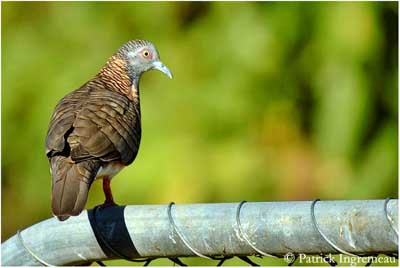
RANGE:
Bar-shouldered Dove lives in north-western, northern and eastern Australia. It is also found in southern New Guinea.
BEHAVIOUR:
Bar-shouldered Dove usually occurs in pairs or small groups, and sometimes in larger flocks feeding on the ground. This species forages mainly on ground, searching for seeds and green parts of some plants. It feeds by day. During the dry season, we can see large flocks around concentration of food. They feed in short grass and mainly near cover. If disturbed, bar-shouldered Dove flies up into nearby trees.
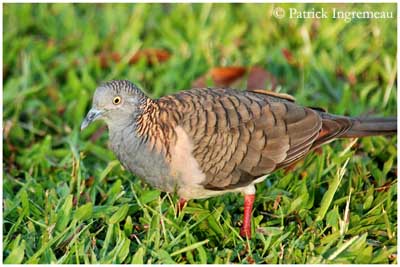
During breeding periods, male performs displays. Bowing display shows the male in front of female while it raises its body before to bow low, with raised and fanned tail, and uttering a nasal “coo”.
It also performs flight displays, flying up steeply with active and noisy wing beats, and then, gliding down in curved way to a perch with spread wings and tail.
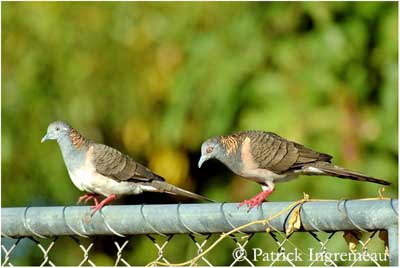
FLIGHT:
Bar-shouldered Dove flies low and performs swift, direct flight. When it takes off, its wings clatter loudly. When in flight, we can hear a whistle produced by the wings.
REPRODUCTION:
Breeding season occurs at any time in the north, but mainly in wet periods, usually from September to January in the south, and between February and April in the north.
Bar-shouldered Dove breeds in mangroves or scrub. Nest is usually placed in trees or shrubs, relatively low at about 1 to 4 metres above the ground, and hidden into vegetation. It is a loose platform, made with twigs and rootlets, placed in a fork or on a branch.
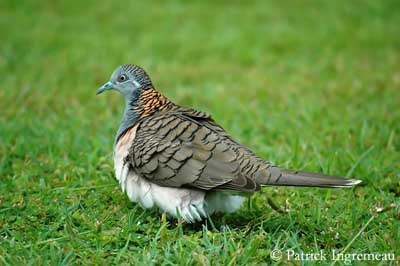
Female lays two white eggs. Incubation lasts about 14 to 16 days, by both parents. Chicks are fed by both adults, with “crop milk” as other pigeons and doves. Young fledge about 16 to 21 days after hatching.
DIET:
Bar-shouldered Dove forages on the ground. It feeds mainly on seeds of varied plants such as grasses and sedges, but it can also eat rhizomes. This species needs to drink regularly during the day.
